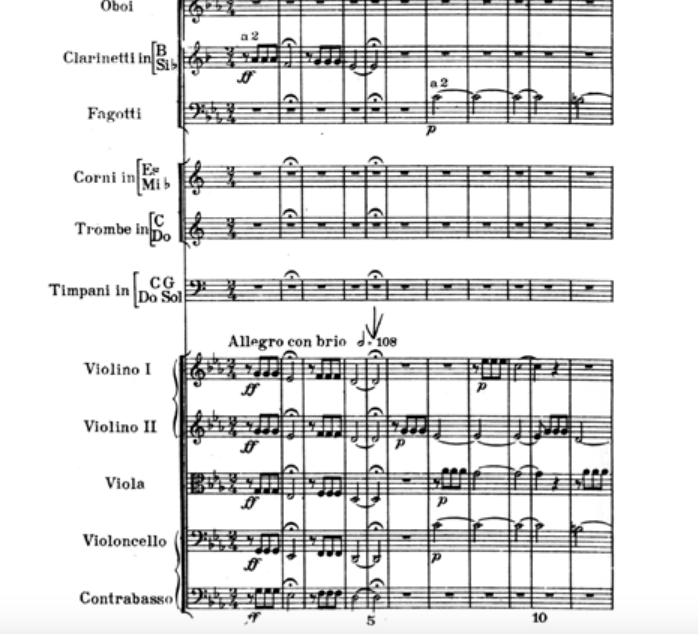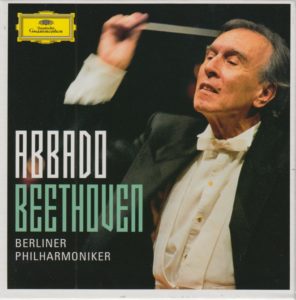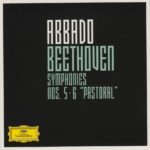
This morning is a return to the top of the batting order with Claudio Abbado (1933-2014), the Berliner Philharominiker, and – this time – Beethoven’s Symphony No. 5 in C minor.
In addition, today marks the return of me visiting the Restaurant-Chain-That-Must-Not-Be-Named. So, shhhh. Don’t tell anyone.
Before I really get rocking and rolling, here’s something a friend shared with me.
If you dig that (and why wouldn’t you?), visit the YouTube channel of its creator: DoodleChaos.
Beethoven’s Fifth begins with four of the most famous notes in Classical music history: Three Gs and a B flat. By now, every person on the planet has heard at least that, in one form or another, from Beethoven.

From its entry on Wikipedia:
The Symphony No. 5 in C minor of Ludwig van Beethoven, Op. 67, was written between 1804–1808. It is one of the best-known compositions in classical music, and one of the most frequently played symphonies. First performed in Vienna’s Theater an der Wien in 1808, the work achieved its prodigious reputation soon afterward. E. T. A. Hoffmann described the symphony as “one of the most important works of the time”. As is typical of symphonies in the classical period, Beethoven’s Fifth Symphony is in four movements.
It begins with a distinctive four-note “short-short-short-long” motif.
The symphony, and the four-note opening motif in particular, are known worldwide, with the motif appearing frequently in popular culture, from disco versions to rock and roll covers, to uses in film and television.
Like Beethoven’s Eroica (=heroic) and Pastorale (=rural), Symphony No. 5 was given an explicit name, besides the numbering. It became popular under “Schicksals-Sinfonie” (=symphony of destiny), and the famous five bar theme was coined “Schicksals-Motiv”. This name is also used in translations.
The Fifth Symphony had a long development process, as Beethoven worked out the musical ideas for the work. The first “sketches” (rough drafts of melodies and other musical ideas) date from 1804 following the completion of the Third Symphony. However, Beethoven repeatedly interrupted his work on the Fifth to prepare other compositions, including the first version of Fidelio, the Appassionata piano sonata, the three Razumovsky string quartets, the Violin Concerto, the Fourth Piano Concerto, the Fourth Symphony, and the Mass in C. The final preparation of the Fifth Symphony, which took place in 1807–1808, was carried out in parallel with the Sixth Symphony, which premiered at the same concert.
Beethoven was in his mid-thirties during this time; his personal life was troubled by increasing deafness. In the world at large, the period was marked by the Napoleonic Wars, political turmoil in Austria, and the occupation of Vienna by Napoleon’s troops in 1805. The symphony was written at his lodgings at the Pasqualati House in Vienna. The final movement quotes from a revolutionary song by Claude Joseph Rouget de Lisle.
The Fifth Symphony was premiered on 22 December 1808 at a mammoth concert at the Theater an der Wien in Vienna consisting entirely of Beethoven premieres, and directed by Beethoven himself on the conductor’s podium.
 Can you imagine that?
Can you imagine that?
Beethoven conducted his own symphony!
I would love to have been there, although that would make me over two centuries old today.
So, unless I jump into the Time Tunnel and tumble out (wearing my jacket with patches on the elbows) in 1808 in the audience with Ludwig conducting the orchestra, I’m happy being me at my age here in 2018.
I have encountered Maestro Abbado four other times in my Beethoven project, on…
Day 1. Rating: None
Day 19. Rating: “Meh!”
Day 37. Rating: “Meh!”
Day 55. Rating: “Huzzah!”
What will today bring?
I will soon find out.
 Beethoven wrote his symphonies in four parts (except for the Sixth, which is in five). The time breakdown of this particular one (Symphony No. 5 in C minor), from this particular conductor (Abbado, at age 68) and this particular orchestra (Berliner Philharmoniker), at this particular time in history (February, 2001) on this particular record label (Deutsche Grammophon) is as follows:
Beethoven wrote his symphonies in four parts (except for the Sixth, which is in five). The time breakdown of this particular one (Symphony No. 5 in C minor), from this particular conductor (Abbado, at age 68) and this particular orchestra (Berliner Philharmoniker), at this particular time in history (February, 2001) on this particular record label (Deutsche Grammophon) is as follows:
I. Allegro con brio (C minor)………………………………………………………7:25
II. Andante con moto (A♭ major)…………………………………………….9:30
III. Scherzo: Allegro (C minor)……………………………………………………8:00
IV. Allegro (C major)…………………………………………………………………10:38
Total running time: 35:33
My Rating:
Recording quality: 4 (a bit of top end missing)
Overall musicianship: 4 (competent, but not inspired)
CD liner notes: 4 (liner notes consist of all necessary technical detail, plus an essay about Abbado’s approach to conducting Beethoven, translated into E/G/F/I, but virtually nothing about Beethoven himself or his symphonies)
How does this make me feel: 4 (“Meh!”)
It’s probably not fair to Maestro Abbado that he starts the rotation. Listening to a new symphony for the first time is always a bit jarring. I don’t know what to expect, nor do I have anything to which to compare what I’m hearing.
That stated, I don’t know what to make of this performance.
Movement I (inarguably the most famous in all of Classical music) seems too fast to me. Somewhere in the recesses of my memory I recall those first four (actually, the first eight in total) being more ponderous. Heavier. With more space between the notes.
Here, in Maestro Abbado’s hands, they’re rapid. Hardly any space between the notes.
That may mean I’m remembering wrong. Or that he’s playing too fast. Or that he’s playing it exactly right and what I heard before was wrong.
I don’t know.
It’s a fine opening to one of the world’s most famous symphonies. But it’s not terribly exciting.
Movement II is a snooze fest. I don’t recall being so disinterested in a second movement from one of Beethoven’s symphonies before. Maybe it’s just really, really hard to follow up the most famous Movement I with anything close to existing.
Movement III (Scherzo), on the other hand, is lively, interesting…and contains a melody that I’ve heard before from Beethoven (3:28-3:46, and repeating). Is it on a later symphony? Or have I heard this Scherzo rendered in a more powerful way from another conductor? There’s something memorable about this melody. I’ve heard it before.
From its entry on Wikipedia:
The scherzo offers contrasts that are somewhat similar to those of the slow movement in that they derive from extreme difference in character between scherzo and trio … The Scherzo then contrasts this figure with the famous ‘motto’ (3 + 1) from the first movement, which gradually takes command of the whole movement.” he third movement is also notable for its transition to the fourth movement, widely considered one of the greatest musical transitions of all time.
The Scherzo offers some very nice pizzicato, which is one of my favorite orchestral sounds, especially noticeable from 6:58-7:23. I don’t know what it is about pizzicato. But it always makes me smile and think of cartoon characters sneaking up on one another.
Movement IV is fascinating for it jumping right out of the gate. No pause between, as it notes in the Wiki article. Just…boom.
Abbado’s Allegro (Movement IV) is quite nice. But I’m almost positive I’m going to hear better in the next 17 days.
Overall, this is a solid performance. But not terribly inspired.
I can’t award it any higher than “Meh!”…
…and wait to hear what else other conductors, orchestras, and different periods of time of performance brings.
